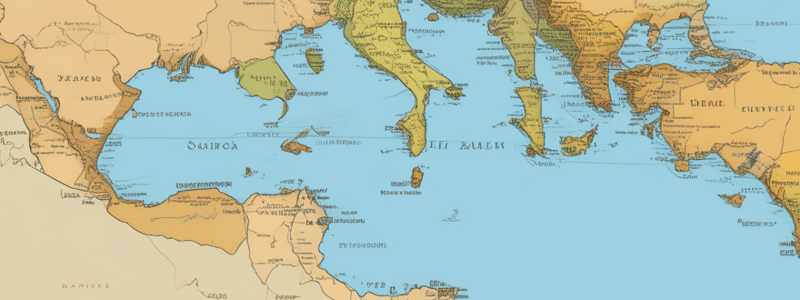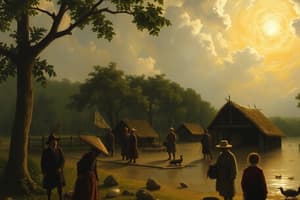Podcast
Questions and Answers
What was the main reason behind Christopher Columbus' voyage in 1492?
What was the main reason behind Christopher Columbus' voyage in 1492?
- To discover new foods and plants
- To spread diseases to the New World
- To find a faster and easier way to reach Asia (correct)
- To introduce slavery to the Americas
What was the term coined by Alfred Crosby to describe the exchange of plants, fruits, and diseases between the Old and New Worlds?
What was the term coined by Alfred Crosby to describe the exchange of plants, fruits, and diseases between the Old and New Worlds?
- The New World Trade
- Columbus' Voyage
- The Columbian Exchange (correct)
- The Age of Exploration
What was one of the negative consequences of the Columbian Exchange?
What was one of the negative consequences of the Columbian Exchange?
- The establishment of new trade routes
- The spread of diseases to the New World (correct)
- The introduction of new foods to the Old World
- The growth of slavery in the Americas
What was brought from the Old World to the New World by Christopher Columbus in 1493?
What was brought from the Old World to the New World by Christopher Columbus in 1493?
What percentage of the native population in the Americas was destroyed by diseases?
What percentage of the native population in the Americas was destroyed by diseases?
What is one example of a fruit that was introduced to Europe from the New World?
What is one example of a fruit that was introduced to Europe from the New World?
What is one example of a domesticated animal that was introduced to the New World from Europe?
What is one example of a domesticated animal that was introduced to the New World from Europe?
What was the major consequence of smallpox being introduced to the New World?
What was the major consequence of smallpox being introduced to the New World?
What was the primary purpose of Christopher Columbus's voyages?
What was the primary purpose of Christopher Columbus's voyages?
What was the main characteristic of the slavery system that emerged during the Columbian Exchange?
What was the main characteristic of the slavery system that emerged during the Columbian Exchange?
What was the primary goal of European countries during the Columbian Exchange?
What was the primary goal of European countries during the Columbian Exchange?
What was the main route of the Triangular Trade?
What was the main route of the Triangular Trade?
What was one of the significant consequences of the Columbian Exchange?
What was one of the significant consequences of the Columbian Exchange?
What was the Middle Passage?
What was the Middle Passage?
What was one of the Old World crops that thrived in the New World?
What was one of the Old World crops that thrived in the New World?
Flashcards are hidden until you start studying
Study Notes
The Columbian Exchange
- An exchange of plants, fruits, vegetables, diseases, and other items between the Old World (Europe, Asia, and Africa) and the New World (The Americas) after Christopher Columbus's explorations in 1492.
Christopher Columbus and the Columbian Exchange
- Christopher Columbus introduced New World items like peppers, tobacco, and chocolate to Europe in 1492.
- He brought Old World items like horses, cattle, and pigs to the New World in 1493.
Goods Traded
- From the New World to the Old World: maize, peanuts, pineapple, potatoes, tomatoes, habanero peppers, turkeys, llamas, tobacco.
- From the Old World to the New World: sugarcane, coffee, horses, pigs, sheep, chickens.
Disease and the Columbian Exchange
- Multiple diseases were exchanged, including smallpox, which was brought from the Old World to the New World and killed many natives.
- 90% of the native population was destroyed by diseases due to lack of immunity.
- Diseases were sometimes used as biological warfare.
Slavery and the Columbian Exchange
- Christopher Columbus enslaved the Taino people, and other explorers followed his example.
- Slavery became a race-based system, where humans were viewed as property.
- The need for labor in plantations led to the exploitation of the slave market.
The Columbian Exchange and Economics
- The Columbian Exchange led to the establishment of the Transatlantic Trade Route, also known as Triangular Trade.
- Europe was the main player in this trading route, which involved the exchange of goods, including enslaved people, between Europe, West Africa, and the Americas.
Importance of the Columbian Exchange
- The Columbian Exchange increased food production around the world.
- Old World crops like sugar, wheat, barley, and rice thrived in the New World, leading to new industries.
- The introduction of new animals like horses, cattle, sheep, and pigs also had a significant impact.
Pros and Cons of the Columbian Exchange
- Pros: introduction of new foods, increase in nutritional value, agricultural revolution.
- Cons: disease, introduction of slavery, institution of chattel slavery.
Studying That Suits You
Use AI to generate personalized quizzes and flashcards to suit your learning preferences.




